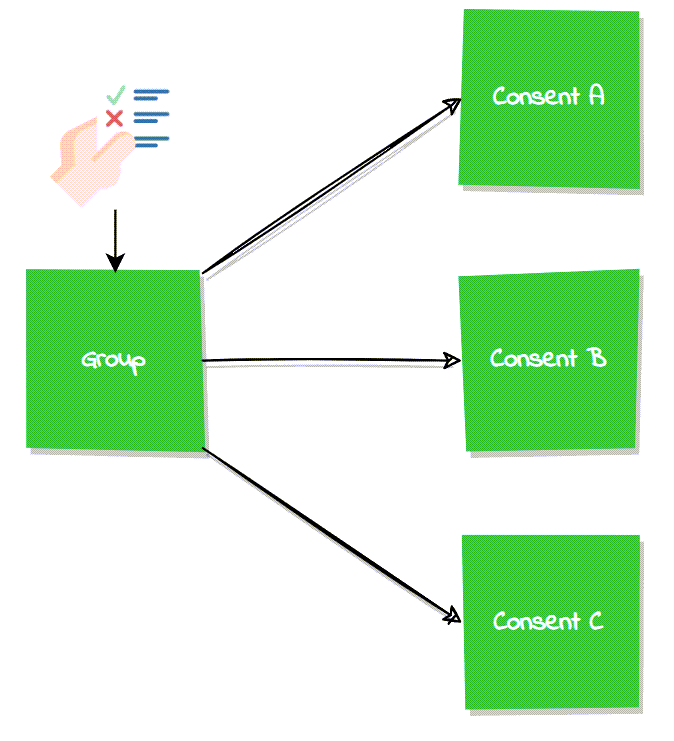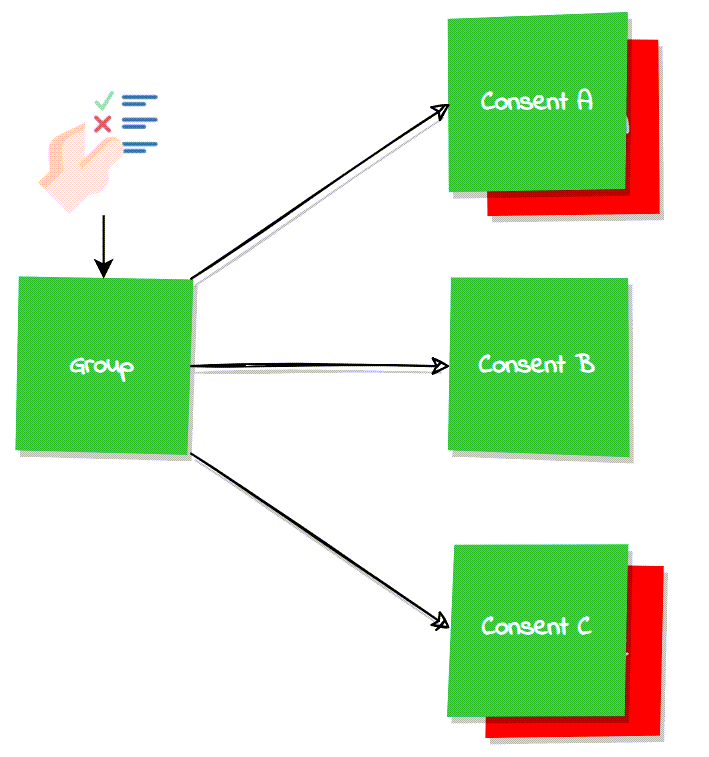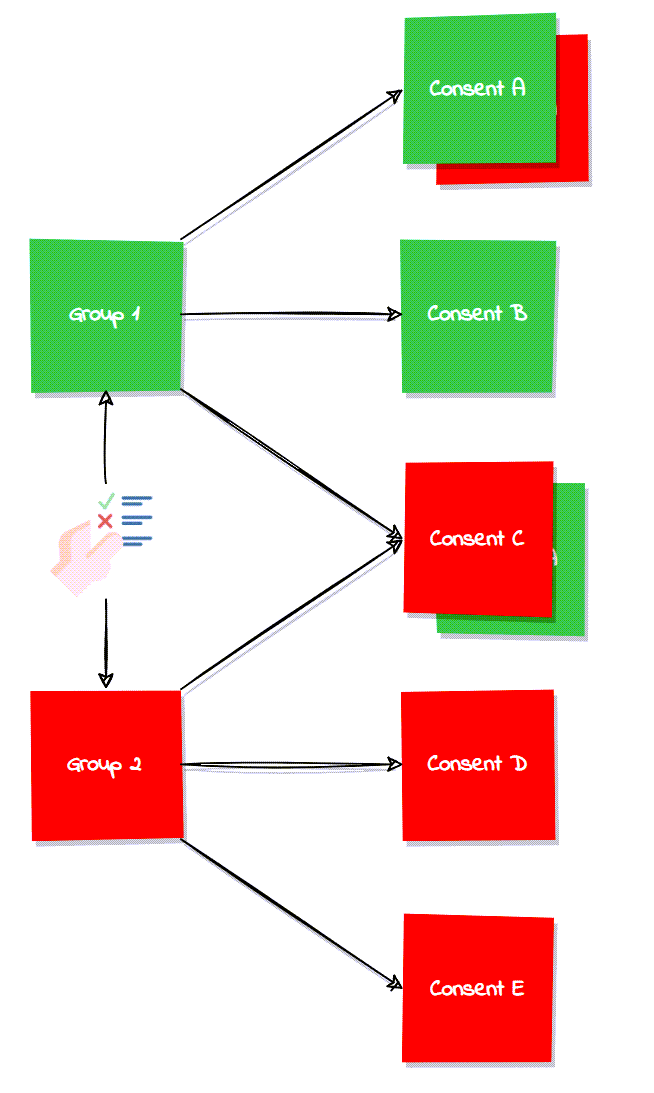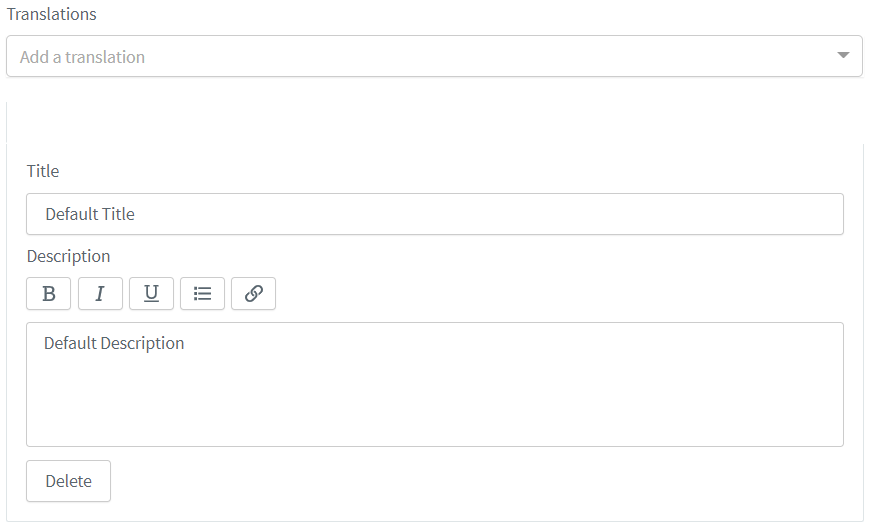Consent groups
If you want to group multiple standalone consents into a more user-friendly way, you may wish to use consent groups. It presents the same consents as multiple standalone consents but in a collection presented as a single touchpoint that can be reviewed and accepted by your users. This page provides you with information on how consent groups work as well as how to create one from the ReachFive Console.
| Groups can only contain one level, meaning there are no nested groups. |
Consent groups rules
Consent Groups are a user-friendly way to validate multiple standalone consents at once and function in one direction (from group to consents). This feature has been developed to allow brands to display a group of consents to end users in a signup process for instance, instead of showing a full list of standalone consents that might take away from their user experience or even completely deter them from signing up.
| The example scenarios below give you a visual of how consent group acceptance works. |
-
Groups can have one or more standalone consents in them.
-
A standalone consent can be part of multiple groups, and in that case, the latest group acceptance or rejection defines the grant of the standalone consent being either
acceptedorrejected. -
The acceptance or rejection is only one way (from group to consents).
-
Groups themselves are not a state of consents, but rather act as a facilitator to validate multiple standalone consents at once, meaning that we do not maintain a logical acceptance or rejection status of the group if the elements of the group have been granted or rejected at a later point in time.
-
Groups acceptances or rejections can be found in the User consent log.
-
Groups acceptance or rejections are not found directly in the user profile; we only store standalone consents here.
-
Groups are one level deep only; nested groups are not supported.
Example scenarios
The scenarios in the tabs below provide three example scenarios.
| This is not an exhaustive list of scenarios, but acts as a guide for you to understand the basic logical flow for how Consent Groups work with ReachFive. |
The term history below essentially means the user had accepted or rejected a standalone consent that is part of the consent group.
In this first example scenario, a user opts into a consent group with no prior interaction with any of the standalone consents that are part of the group.

In this second example scenario, a user opts into a consent group when they had previously rejected Consent A and Consent C.

In this third example scenario, a user opts into Group 1 and rejects Group 2 when they had previously rejected Consent A and accepted Consent C.

Manage Consent groups from console
You can create, update, and archive user Consent groups easily from the ReachFive Console.
| If you do not see the Consent group option available on your ReachFive Console, get in touch with ReachFive Support as the feature may need to be enabled. |
Prerequisites
-
You must have access to the ReachFive Console.
-
You must have a Developer, Manager, or Administrator role.
-
You must have the Consents feature enabled.
Instructions
-
Log in to your ReachFive Console.
-
Navigate to .
-
Create, edit, or archive a Consent group.
-
Click New Consent group.
-
Enter a Key for your Consent group.
-
Choose the Consent group Type.
-
opt-in: requires an explicit action by the user on signup. -
double-opt-in: requires an explicit action by the user on signup as a typical "single" opt-in. However, there is an additional step required here where the user (via SMS or email) must confirm the choice to opt-in, adding further peace of mind and security for your users. -
opt-out: is automatically accepted on user signup. If a user does not want to accept the given processing purpose, the user must explicitly opt out of it.Opt-outs are considered lawful only if justified by legitimate interest. -
If you choose a double-opt-in type, you’ll need to choose the Preferred channel.
-
-
-
Add a Tag. Hit Enter to ensure the tag is received.
Tags are normalized before being saved. This means that trailing spaces are removed and all letters are converted to lowercase. Duplicate tags are also removed. -
Under the Version 1 tab, add a Translation for your Consent.
Make sure you first add a translation for the account’s default language. After that, you can add as many translations as you like.
-
Choose the language for your translation from the dropdown menu.
-
Give the consent translation a Title.
This is the primary text that the user sees when consenting. -
Write a Description for the consent translation.
This describes the consent to the user. For example, "Sign up to our newsletter".
-
Associate the standalone consents you want to include as part of the consent group.
-
Don’t forget to Save your input.
-
Click the
 under Actions.
under Actions. -
Update your Consent group as needed.
It is okay to edit an existing Consent group version. However, if there are substantial changes that impact what the user is agreeing (or not agreeing) to. We highly recommend that you create a new version.
-
To add a new Consent group version, click Add new version.
-
Choose the language for your translation from the dropdown menu.
-
Give the consent translation a Title.
This is the primary text that the user sees when consenting. -
Write a Description for the consent translation.
This describes the consent to the user. For example, "Sign up to our newsletter".
-
Don’t forget to Save your input.
-
Find the Consent group that you would like to archive.
-
Click the
 under Actions.
under Actions. -
Click Yes when the pop-up asks if you want to archive the consent.
You can see the consent is archived when it is greyed out as shown in the image below. 
You can reactivate a consent at any time. -
Consent group helpers
This section provides important definitions and interface help for using and managing Consent group from the ReachFive Console.
Here you find definitions or common items and terms on the Consents UI as well as a description of icons.
Definitions
| Item | Required | Description | ||||||||||||
|---|---|---|---|---|---|---|---|---|---|---|---|---|---|---|
✓ |
Uniquely identifies a Consent group. This key is used to reference the Consent group in the ReachFive SDK.
|
|||||||||||||
✓ |
The title of the Consent group.
|
|||||||||||||
Describes the Consent group to the user in more detail. You can use a few shortcuts for writing in the text box on the ReachFive Console for consents.
|
||||||||||||||
✓ |
Specifies the Consent group type.
To have the Explicit Opt-Out Grant feature enabled, please let your ReachFive contact know you want the feature and we’ll enable it for you.
|
|||||||||||||
A string tag (label) that can be added to Consent groups. This improves filtering and categorizing Consent groups via the ReachFive Console.
|
||||||||||||||
Consent group versions allow you to offer different versions of a single Consent group. For example, if you need to know what is accepted in the Consent group, but the Consent group is standard across your offerings, creating a new Consent group version allows you to manage this from one place in the ReachFive Console.
|
||||||||||||||
Allows you to set different translation for the Consent group title and description.
|
UI help
| Item | Description | ||
|---|---|---|---|
|
Edits a Consent group. |
||
|
Filters Consent groups. You can search by |
||
Archives a Consent group. You can reactivate an archived Consent group at any time.
|
|||
|
Reactivates a previously archived Consent group. |
Consent group versions
When creating a Consent group, Version 1 is automatically available to you where you (at a minimum) add the translation for your default account language.
There are a few general rules related to consent versions that are important to understand:
-
If you are managing consents via the Consents API or importing consents, there is no requirement to provide version details as this happens automatically.
-
If you do not provide version details, however, ReachFive assumes that the latest version and default language are what should be used.
| If you want more control over consent versions, you should provide details as this will allow you to more easily differentiate between versions. |
Consent groups API
The endpoint for Consent Groups is the same as for standalone Consents. The primary difference is the associated_consents field in the JSON payload.
/api/v1/consents| Operation | Notes |
|---|---|
GET |
List all known consent groups. |
GET |
Retrieve a specific consent group where |
POST |
Create a consent group. |
PUT |
Update a consent group where |
DELETE |
Delete a consent group where |
Consent Group payload
{
"key": "cgu",
"consent_type": "opt-in",
"tags": [
"web",
"weekly"
],
"versions": [
{
"version_id": 1,
"author_name": "auser@mailbox.com",
"translations": {
"en": {
"description": "I agree to the End User License Agreement.",
"title": "EULA"
}
}
}
],
"status": "active",
"associated_consents" : ["key1", "key2"] (1)
}| 1 | The associated_consents array contains the keys of all standalone consents that are part of this specific Consent Group. |






